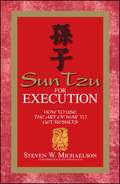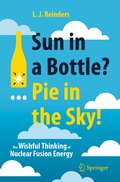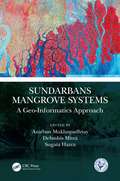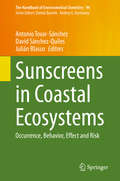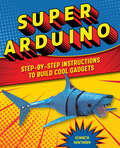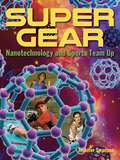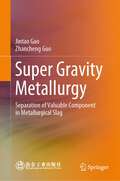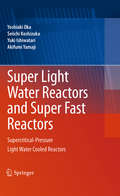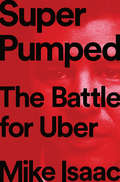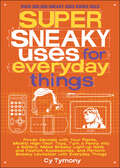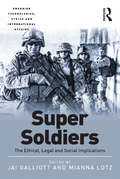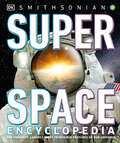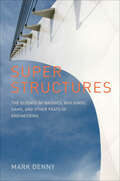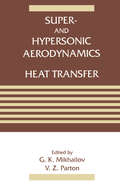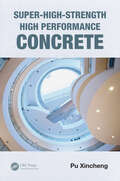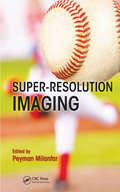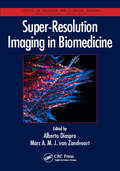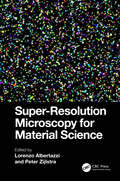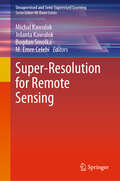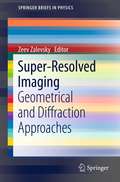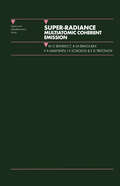- Table View
- List View
Sun Tzu For Execution: How to Use the Art of War to Get Results
by Steven W MichaelsonA Simon & Schuster eBook. Simon & Schuster has a great book for every reader.
Sun in a Bottle?... Pie in the Sky!: The Wishful Thinking of Nuclear Fusion Energy
by L. J. ReindersThis book gives an accessible overview of the 70-year history of nuclear fusion research and the vain attempts to construct an energy-generating nuclear fusion reactor. It shows that even in the most optimistic scenario nuclear fusion, despite the claims of its proponents and the billions being spent on research, will not be able to make a sizable contribution to the energy mix in this century. The important consequence is that nuclear fusion will not be a factor in combating climate change, since the race for carbon-free energy will have been won or lost long before the first nuclear fusion power station comes on line.
Sundarbans Mangrove Systems: A Geo-Informatics Approach
by Anirban Mukhopadhyay Debashis Mitra Sugata HazraSundarbans, a UNESCO heritage site, is the world’s largest single chunk of mangroves distributed on the Indian and Bangladesh coasts. The mangroves and associated ecosystems are one of the most fertile ecosystems of the earth. Sundarbans Mangrove Systems: A Geo-Informatics Approach portrays different perspectives of studying Sundarbans and mangroves using geospatial analysis. This book highlights the major issues with the Sundarbans mangrove forest, its future conservation strategies and its ecological importance using geo-informatics technology. It explains the usage of remote sensing data for providing information about the present state of mangroves and their tropic status, including assessment in terms of extent, density of community, condition, diversity, identifying potential habitats and heterogeneity. Furthermore, it discusses the use of hyperspectral remote sensing data for species level classification of mangroves, community zonation for biodiversity assessment and for preparing management plans for conservation. KEY FEATURES Exclusively covers the ecological state of Sundarbans (mangrove systems) through geo-informatic studies Describes the application of a combination of geomorphological, biogeochemical and remote sensing methods to the analysis of temporal changes Includes environmental factors affecting the health and decline of mangroves Covers biodiversity and ecological controls in mangroves ecosystems Discusses a remote sensing approach for tropical forested island and mangroves mapping This book is aimed at graduate students and researchers in environmental sciences, ecology, marine sciences, biology, geosciences and GIS/remote sensing areas.
Sunny: A Novel
by Colin O'SullivanSOON TO BE A MAJOR STREAMING SERIESA riveting technological thriller following a woman whose life is upended when her husband and son disappear in a mysterious plane crash and she is left alone with an unnerving home robot, only to get caught up in an AI-related conspiracy. In near-future Japan, Susie Sakamoto is mourning the loss of her husband and son to a plane crash. Alone in her big modern house, which feels like more of a prison, Susie spends her days drinking heavily and taking her anger out at the only “sentient” thing left in her life: Sunny, the annoying home robot her husband designed. Susie despises Sunny, and sometimes even gets a sinking feeling that Sunny is out to hurt her.To escape her paranoia and depression, Susie frequents the seedy, drug-fueled bars of the city, where she hears rumors of The Dark Manual, a set of guidelines that allow you to reprogram your robot for nefarious purposes. In the hopes of finding a way to turn off Sunny for good, Susie begins to search for the manual, only to learn it’s too late: the machines are becoming more sentient and dangerous. Thrust into the center of a dark, corporate war, Susie realizes there’s someone behind the code, pulling the strings. And they want her dead.With a darkly humorous yet propulsive and lyrical voice, O’Sullivan presents us with an unsettling look at a future that feels all too real. Gripping and thought-provoking, Sunny is a haunting character study of an anxious woman teetering in an anxious time.
Sunrise at Strawberry Farm: A warm-hearted and uplifting summer romance
by Kellie Hailes'Light hearted and a perfect read for a summer holiday - you can almost taste the strawberries' NetGalley reviewerFirst love can be as sweet as strawberries... Hannah Beety never thought she'd be back working at her family's strawberry farm, but when her mother falls ill, she knows it's time to go home. Returning to help in time for the summer harvest, Hannah's forced to face up to the broken hearts she left behind... After a decade, Grey Walker cannot believe that the woman he had planned to marry, start a family and live a cosy life with is back. Working side by side with Hannah as they prepare for the annual Strawberry Festival brings back all the memories of his first love he'd tried to bury. But as the summer days lengthen, could letting her in mean losing his heart, again? As delightfully delicious as strawberries and cream in the sunshine. This is the perfect summer romance to indulge in, perfect for fans of Katie Fforde, Jane Linfoot and Cressida McLaughlin.'Just what I needed to read in these strange times, light hearted, great characters and good story line. An escapism read.' NetGalley Reviewer'really lovely reading and a fabulous ending' NetGalley ReviewerReaders love Kellie Hailes's gorgeous summer romances:'Great characters, easy read, uplifting, funny, romantic and charming...the perfect summer read.' Beanie, NetGalley reviewer'Kellie Hailes knocked it out of the park.' Carrie, NetGalley reviewer'Such a sweet love story, that your heart just melts!' Debbie, NetGalley reviewer'A fun and charming read that I couldn't put down. ... I need to find more books by Kellie Hailes.' Vikkie, NetGalley reviewer
Sunrise at Strawberry Farm: A warm-hearted and uplifting summer romance
by Kellie Hailes'Light hearted and a perfect read for a summer holiday - you can almost taste the strawberries' NetGalley reviewerFirst love can be as sweet as strawberries... Hannah Beety never thought she'd be back working at her family's strawberry farm, but when her mother falls ill, she knows it's time to go home. Returning to help in time for the summer harvest, Hannah's forced to face up to the broken hearts she left behind... After a decade, Grey Walker cannot believe that the woman he had planned to marry, start a family and live a cosy life with is back. Working side by side with Hannah as they prepare for the annual Strawberry Festival brings back all the memories of his first love he'd tried to bury. But as the summer days lengthen, could letting her in mean losing his heart, again?As delightfully delicious as strawberries and cream in the sunshine. This is the perfect summer romance to indulge in, perfect for fans of Katie Fforde, Jane Linfoot and Cressida McLaughlin.'Just what I needed to read in these strange times, light hearted, great characters and good story line. An escapism read.' NetGalley Reviewer'really lovely reading and a fabulous ending' NetGalley ReviewerReaders love Kellie Hailes's gorgeous summer romances:'Great characters, easy read, uplifting, funny, romantic and charming...the perfect summer read.' Beanie, NetGalley reviewer'Kellie Hailes knocked it out of the park.' Carrie, NetGalley reviewer'Such a sweet love story, that your heart just melts!' Debbie, NetGalley reviewer'A fun and charming read that I couldn't put down. ... I need to find more books by Kellie Hailes.' Vikkie, NetGalley reviewer
Sunscreens in Coastal Ecosystems: Occurrence, Behavior, Effect and Risk (The Handbook of Environmental Chemistry #94)
by Julián Blasco Antonio Tovar-Sánchez David Sánchez-QuilesThis book provides a comprehensive and authoritative review of the chemical analysis of UV filters in coastal waters and their impact on the marine environment. The sun care is today the most important sector within the cosmetics industry, with annual increases in sales. The main components of sunscreens, organic and inorganic UV filters, have been detected in many coastal regions, with the highest concentrations in coastal areas under high anthropogenic pressure. Moreover, these compounds have been found to be bioaccumulated in aquatic biota causing biological and toxicological responses; some organic UV filters act as endocrine disruptors in aquatic biota, affecting survival, behavior, growth, development and reproduction. On the other hand, inorganic UV filters, mainly based on nanoparticles, have been demonstrated to have various impacts on marine organisms, such as inducing oxidative stress in abalones, accumulating in microalgae, affecting the immune response in mussels, bleaching corals, and genotoxicity in fish, among others. All these effects of sunscreens on the marine environment highlight the need for more stringent and environmentally friendly regulations. This book covers the latest analytical methodologies used in assessing the impact of UV filters impact on marine waters, especially on marine biota, and also critiques the global regulation of UV filters and the environmental risk of using sunscreens. Featuring specific case studies of the environmental effects of sunscreens in the Mediterranean Sea and Hawaii, which highlight the importance of balancing human health with environmental health of coastal ecosystems, it will appeal not only to scientists and students from various disciplines (environmental chemistry, biology, ecology, biogeochemistry, fisheries and climate change among others), but also to environmental managers wanting to promote new restrictive regulations on the use of UV filters, and to professionals from the cosmetic industry interested in the development of eco-friendly sunscreens.
Super Arduino: Step-by-Step Instructions to Build Cool Gadgets
by Kenneth HawthornGeek out—amazing gadget projects for Arduino beginners. Welcome to the wonderful wired world of Arduino—the flexible open-source electronics platform for creators. Become a coding superhero with Super Arduino—the easiest step-by-step, project-based guide for beginners who want to learn the latest tips and tricks while taking their DIY programming skills to the next level. Let your engineering imagination run wild. In this Arduino project workbook, you'll learn how to create great gadgets like a fabulous flag-waver, flashing disco shoes, a crazy clock, flip-a-switch with Wi-Fi, and even an echolocation distance sensor—like a bat! So what are you waiting for? Plug into Super Arduino and get the following: Calling all coders—Explore these easy-to-follow programming sketches specifically designed for Arduino beginners. Ignite your imagination—You'll make wired wearables, crazy costumes, and even home gadgets using step-by-step Arduino projects that build your skills—and coding confidence. Full-color format—From start to finish, four-color sketch images will help guide you. If you can dream it, there's a good chance you can build it—with this awesome Arduino beginner's guide.
Super Gear: Nanotechnology and Sports Team Up
by Jennifer SwansonCutting-edge science; high-performance sports How are the sports played by Michael Phelps, Serena Williams, Michelle Wie, and Usain Bolt related? Nanotechnology! Take a close-up look at sports and nanotechnology, the cutting-edge science that manipulates objects at the atomic level. Nanotechnology is used to create high-tech swimsuits, tennis rackets, golf clubs, running shoes, and more. It is changing the face of sports as we know it. Back matter includes a glossary, bibliography, list of resources, and index. Perfect for 2016 Summer Olympics displays and celebrations.
Super Gravity Metallurgy: Separation of Valuable Component in Metallurgical Slag
by Zhancheng Guo Jintao GaoThis book introduces super gravity metallurgy in separation of valuable component in metallurgical slag. It collects the principle, apparatus and research for super gravity high-temperature metallurgy and the novel technology for selective crystallization and separation of various valuable components in different metallurgical slags by super gravity. Furthermore, the research results previously scattered in many journals and conferences worldwide are methodically edited and presented in a unified form. The book is likely to be of interest to university teachers, researchers, R&D engineers and graduate students in pyrometallurgy and extractive metallurgy who wish to explore innovative methods and technologies that lead to more efficient and environmentally sustainable utilization of metallurgical slag.
Super Light Water Reactors and Super Fast Reactors
by Akifumi Yamaji Yuki Ishiwatari Seiichi Koshizuka Yoshiaki OkaSuper Light Water Reactors and Super Fast Reactors provides an overview of the design and analysis of nuclear power reactors. Readers will gain the understanding of the conceptual design elements and specific analysis methods of supercritical-pressure light water cooled reactors. Nuclear fuel, reactor core, plant control, plant stand-up and stability are among the topics discussed, in addition to safety system and safety analysis parameters. Providing the fundamentals of reactor design criteria and analysis, this volume is a useful reference to engineers, industry professionals, and graduate students involved with nuclear engineering and energy technology.
Super Pumped: The Battle For Uber
by Mike IsaacA New York Times technology correspondent presents the dramatic story of Uber, the Silicon Valley startup at the center of one of the great venture capital power struggles of our time. <P><P>In June 2017, Travis Kalanick, the hard-charging CEO of Uber, was ousted in a boardroom coup that capped a brutal year for the transportation giant. Uber had catapulted to the top of the tech world, yet for many came to symbolize everything wrong with Silicon Valley. <P><P>Award-winning New York Times technology correspondent Mike Isaac’s Super Pumped presents the dramatic rise and fall of Uber, set against an era of rapid upheaval in Silicon Valley. Backed by billions in venture capital dollars and led by a brash and ambitious founder, Uber promised to revolutionize the way we move people and goods through the world. A near instant “unicorn,” Uber seemed poised to take its place next to Amazon, Apple, and Google as a technology giant. <P><P>What followed would become a corporate cautionary tale about the perils of startup culture and a vivid example of how blind worship of startup founders can go wildly wrong. Isaac recounts Uber’s pitched battles with taxi unions and drivers, the company’s toxic internal culture, and the bare-knuckle tactics it devised to overcome obstacles in its quest for dominance. With billions of dollars at stake, Isaac shows how venture capitalists asserted their power and seized control of the startup as it fought its way toward its fateful IPO. <P><P>Based on hundreds of interviews with current and former Uber employees, along with previously unpublished documents, Super Pumped is a page-turning story of ambition and deception, obscene wealth, and bad behavior that explores how blistering technological and financial innovation culminated in one of the most catastrophic twelve-month periods in American corporate history. <P><P><b> A New York Times Bestseller </b>
Super Sneaky Uses for Everyday Things: Power Devices with Your Plants, Modify High-Tech Toys, Turn a Penny into a Battery, Make Sneaky Light-Up Nails and Fashion Accessories, and Perform Sneaky Levitation with Everyday Things (Sneaky Books #8)
by Cy TymonyThe popular Sneaky Uses series continues with an all-new volume of more than thirty outlandish inventions made from ordinary objects and materials. Author and mad scientist Cy Tymony has turned his passion for tinkering into sneaky science movement, teaching parents and kids all over the world how to turn ordinary household items into amazing inventions. In this volume of his popular Sneaky Uses series, he shares more than thirty new projects, including homemade toys, games, fashion, science tricks, and more! Each activity begins with a complete list of materials followed by easy-to-follow, step-by-step instructions, and helpful illustrations. Fans of all ages will use their ingenuity to turn everyday objects into something extraordinary with the help of Super Sneaky Uses for Everyday Things.
Super Soldiers: The Ethical, Legal and Social Implications (Emerging Technologies, Ethics and International Affairs)
by Jai Galliott Mianna LotzThe Spartan City State produced what is probably one of the most iconic and ruthless military forces in recorded history. They believed that military training and education began at birth. Post-World War II saw a shift to army tanks, fighter jets and missiles that would go on to fight the next huge battle in Northern Europe. Today, with the advent of unmanned systems, our hopes are attached to the idea that we can fight our battles with soldiers pressing buttons in distant command centres. However, soldiers must now be highly trained, super strong and have the intelligence and mental capacity to handle the highly complex and dynamic military operating environment. It is only now as we progress into the twenty-first century that we are getting closer to realising the Spartan ideal and creating a soldier that can endure more than ever before. This book provides the first comprehensive and unifying analysis of the moral, legal and social questions concerning military human enhancement, with a view toward developing guidance and policy that may influence real-world decision making.
Super Space Encyclopedia: The Furthest, Largest, Most Spectacular Features of Our Universe (DK Super Nature Encyclopedias)
by DKExplore our wonderful universe through stunning CGI illustrations and amazing stats that bring to life the incredible marvels that populate space.Bursting with fascinating facts and the latest breathtaking images, this space book for children brings the wonders of the Solar System to life. Find out about the never-ending storms on Jupiter. Learn about the towering volcanoes of Venus - all 1,600 of them, and see the Valles Marineris on Mars--a canyon that is ten times longer than Earth's Grand Canyon. Find out many more fascinating "super" facts about the cosmos with Super Space Encyclopedia. Based on recent research and discoveries, Super Space Encyclopedia showcases everything you need to know about the Universe--from the Big Bang to the formation of galaxies and planets as well as the technology used to explore it unimaginable depths. Fabulous cutaway artworks help to reveal the inner workings of the Sun, planets, and spacecraft. Super Space Encyclopedia brings the cosmos to life in a visually compelling and informative way, making it a must-have book for every budding space enthusiast.
Super Structures: The Science of Bridges, Buildings, Dams, and Other Feats of Engineering
by Mark DennyEver wonder how a graceful and slender bridge can support enormous loads over truly astonishing spans? Why domes and free-standing arches survive earthquakes that flatten the rest of a city?Physicist Mark Denny looks at the large structures around us—tall buildings, long bridges, and big dams—and explains how they were designed and built and why they sometimes collapse, topple, or burst. Denny uses clear, accessible language to explain the physics behind such iconic structures as the Parthenon, the Eiffel Tower, the Forth Rail Bridge in Edinburgh, and Hoover Dam. His friendly approach allows readers to appreciate the core principles that keep these engineering marvels upright without having to master complex mathematical equations. Employing history, humor, and simple physics to consider such topics as when to use screws or nails, what trusses are, why iron beams are often I-shaped, and why medieval cathedrals have buttresses, Denny succeeds once again in making physics fun.
Super Structures: The Science of Bridges, Buildings, Dams, and Other Feats of Engineering
by Mark DennyAn “extraordinary guide to the hidden secrets of modern man-made miracles . . . Highly recommended” —from the author of Froth!: The Science of Beer (Midwest Book Review).Ever wonder how a graceful and slender bridge can support enormous loads over truly astonishing spans? Why domes and free-standing arches survive earthquakes that flatten the rest of a city?Physicist Mark Denny looks at the large structures around us—tall buildings, long bridges, and big dams—and explains how they were designed and built and why they sometimes collapse, topple, or burst.Denny uses clear, accessible language to explain the physics behind such iconic structures as the Parthenon, the Eiffel Tower, the Forth Rail Bridge in Edinburgh, and Hoover Dam. His friendly approach allows readers to appreciate the core principles that keep these engineering marvels upright without having to master complex mathematical equations.Employing history, humor, and simple physics to consider such topics as when to use screws or nails, what trusses are, why iron beams are often I-shaped, and why medieval cathedrals have buttresses, Denny succeeds once again in making physics fun.Praise for Mark Denny“Denny’s wry humor is fun to read and made me laugh out loud.” —Mark Kidger, author of Astronomical Enigmas“Denny largely sheds the complexity of mathematical constructs, distilling their most salient features into a more qualitative understanding of radar and sonar systems.” —Choice“Indeed, Denny’s writing is anything but dry and boring. He adeptly explains complex subject matter and does so with relatively simple language and minimal use of symbolic notation.” —Bat Research News
Super- and Hypersonic Aerodynamics and Heat Transfer
by V.Z. PartonRecent government and commercial efforts to develop orbital and suborbital passenger and transport aircraft have resulted in a burgeoning of new research. The articles in this book, translated from Russian, were contributed by the world's leading authorities on supersonic and hypersonic flows and heat transfer. This superb book addresses the physics and engineering aspects of ultra high-speed aerodynamic problems. Thorough coverage is given to an array of specific problem-solving equations. Super- and Hypersonic Aerodynamics and Heat Transfer will be essential reading for all aeronautical engineers, mechanical engineers, mathematicians, and physicists involved in this exciting field of research.
Super-High-Strength High Performance Concrete
by Pu XinchengWhen produced correctly, concrete can be extremely strong, with high load-bearing capacity and superior durability. Another noteworthy property is the relatively low amount of energy and resources consumed during production. Super-High-Strength High Performance Concrete brings together the results of a major research project by the National Natural
Super-Resolution Imaging (Digital Imaging and Computer Vision)
by Peyman MilanfarWith the exponential increase in computing power and broad proliferation of digital cameras, super-resolution imaging is poised to become the next "killer app." The growing interest in this technology has manifested itself in an explosion of literature on the subject. Super-Resolution Imaging consolidates key recent research contributions from eminent scholars and practitioners in this area and serves as a starting point for exploration into the state of the art in the field. It describes the latest in both theoretical and practical aspects of direct relevance to academia and industry, providing a base of understanding for future progress. Features downloadable tools to supplement material found in the book Recent advances in camera sensor technology have led to an increasingly larger number of pixels being crammed into ever-smaller spaces. This has resulted in an overall decline in the visual quality of recorded content, necessitating improvement of images through the use of post-processing. Providing a snapshot of the cutting edge in super-resolution imaging, this book focuses on methods and techniques to improve images and video beyond the capabilities of the sensors that acquired them. It covers: History and future directions of super-resolution imaging Locally adaptive processing methods versus globally optimal methods Modern techniques for motion estimation How to integrate robustness Bayesian statistical approaches Learning-based methods Applications in remote sensing and medicine Practical implementations and commercial products based on super-resolution The book concludes by concentrating on multidisciplinary applications of super-resolution for a variety of fields. It covers a wide range of super-resolution imaging implementation techniques, including variational, feature-based, multi-channel, learning-based, locally adaptive, and nonparametric methods. This versatile book can be used as the basis for short courses for engineers and scientists, or as part of graduate-level courses in image processing.
Super-Resolution Imaging in Biomedicine (Series in Cellular and Clinical Imaging)
by Alberto Diaspro and Marc A. M. J. van ZandvoortThis book encompasses the full breadth of the super-resolution imaging field, representing modern techniques that exceed the traditional diffraction limit, thereby opening up new applications in biomedicine. It shows readers how to use the new tools to increase resolution in sub-nanometer-scale images of living cells and tissue, which leads to new information about molecules, pathways and dynamics. The book highlights the advantages and disadvantages of the techniques, and gives state-of-the-art examples of applications using microscopes currently available on the market. It covers key techniques such as stimulated emission depletion (STED), structured illumination microscopy (SSIM), photoactivated localization microscopy (PALM), and stochastic optical reconstruction microscopy (STORM). It will be a useful reference for biomedical researchers who want to work with super-resolution imaging, learn the proper technique for their application, and simultaneously obtain a solid footing in other techniques.
Super-Resolution Microscopy for Material Science
by Lorenzo Albertazzi Peter ZijlstraOptical microscopy is one of the most frequently used tools in chemistry and the life sciences. However, its limited resolution hampers the use of optical imaging to many other relevant problems in different disciplines. Super-Resolution Microscopy (SRM) is a new technique that allows the resolution of objects down to a few billionth of meters (nanometers), ten times better than classical microscopes, opening up opportunities to use this tool in new fields.This book describes the theory, principles, and practice of super-resolution microscopy in the field of materials science and nanotechnology. There is a growing interest in the applications of SRM beyond biology as new synthetic materials, such as nanoscale sensors and catalysts, nanostructured materials, functional polymers, and nanoparticles, have nanoscopic features that are challenging to visualize with traditional imaging methods.SRM has the potential to be used to image and understand these cutting-edge man-made objects and guide the design of materials for novel applications.This book is an ideal guide for researchers in the fields of microscopy and materials science and chemistry as well as graduate students studying physics, materials science, biomedical engineering, and chemistry.Key Features: Contains practical guidance on Super-Resolution Microscopy (SRM), an exciting and growing tool that was awarded the Nobel Prize for chemistry in 2014 Provides a new perspective targeting materials science, unlike existing books which target readers in chemistry, life science, and biology Targets students in its core chapters, while offering more advanced material for professionals and researchers in later chapters
Super-Resolution for Remote Sensing (Unsupervised and Semi-Supervised Learning)
by M. Emre Celebi Michal Kawulok Bogdan Smolka Jolanta KawulokThis book provides a comprehensive perspective over the landscape of super-resolution techniques developed for and applied to remotely-sensed images. The chapters tackle the most important problems that professionals face when dealing with super-resolution in the context of remote sensing. These are: evaluation procedures to assess the super-resolution quality; benchmark datasets (simulated and real-life); super-resolution for specific data modalities (e.g., panchromatic, multispectral, and hyperspectral images); single-image super-resolution, including generative adversarial networks; multi-image fusion (temporal and/or spectral); real-world super-resolution; and task-driven super-resolution. The book presents the results of several recent surveys on super-resolution specifically for the remote sensing community.
Super-Resolved Imaging
by Zeev ZalevskyIn this brief we review several approaches that provide super resolved imaging, overcoming the geometrical limitation of the detector as well as the diffraction effects set by the F number of the imaging lens. In order to obtain the super resolved enhancement, we use spatially non-uniform and/or random transmission structures to encode the image or the aperture planes. The desired resolution enhanced images are obtained by post-processing decoding of the captured data.
Super-radiance: Multiatomic Coherent Emission (Series In Optics And Optoelectronics Ser.)
by M G Benedict A M Ermolaev V A Malyshev I V Sokolov E D TrifonovSuper-radiance: Multiatomic Coherent Emission provides a comprehensive, self-contained account of the theory and experiments of the quantum optic phenomenon of superradiance. Contributed by highly regarded researchers in the field, the book first presents the theory of superradiance at a level suitable for graduate physicists approaching the subject for the first time. This introduction is followed by a more rigorous treatment that is supported by the analysis of experiments dealing with superradiance and by a discussion on the possible uses of the effect in other areas of optics and electronics. The theoretical and experimental results presented in this book will introduce a wide audience to this important area of quantum optics.
